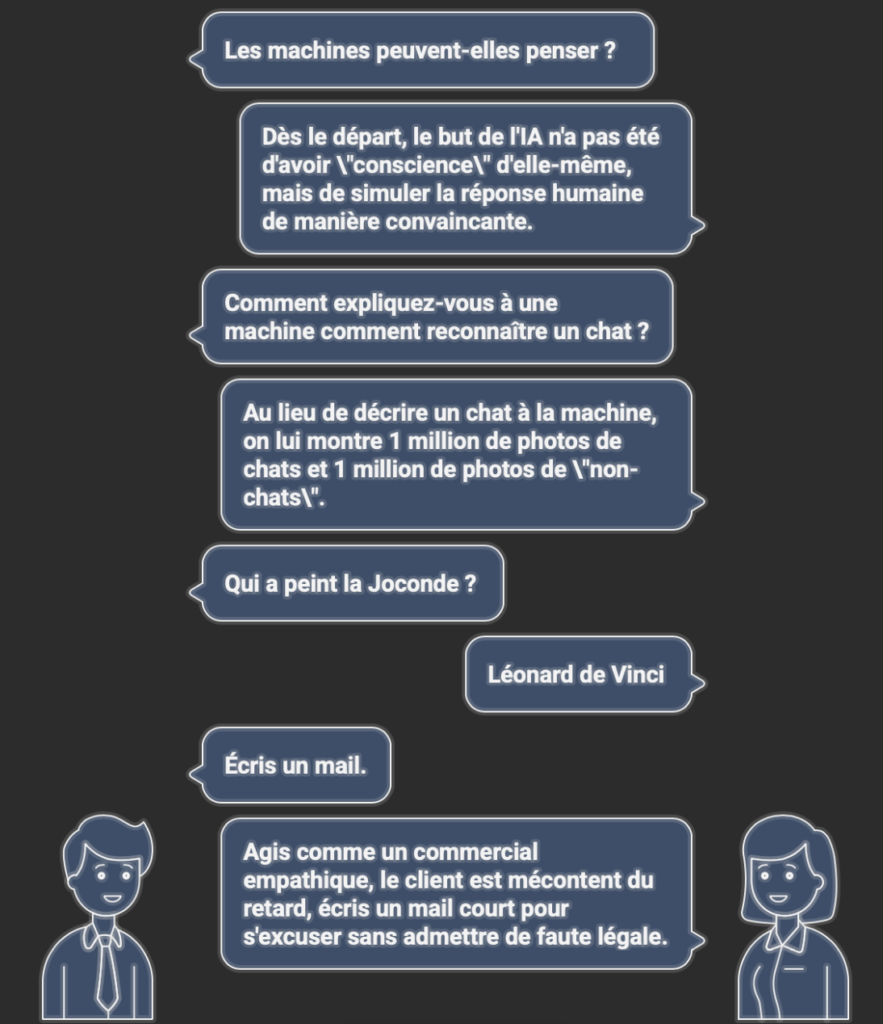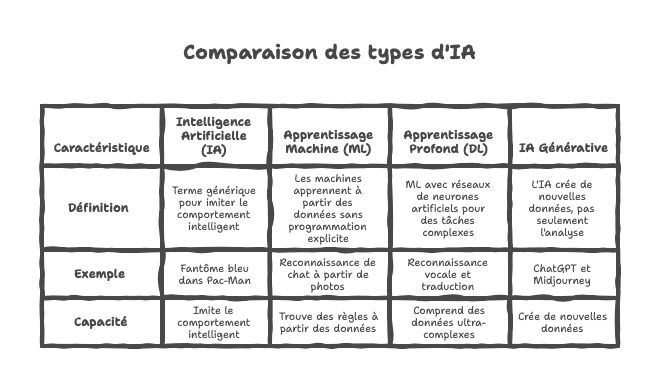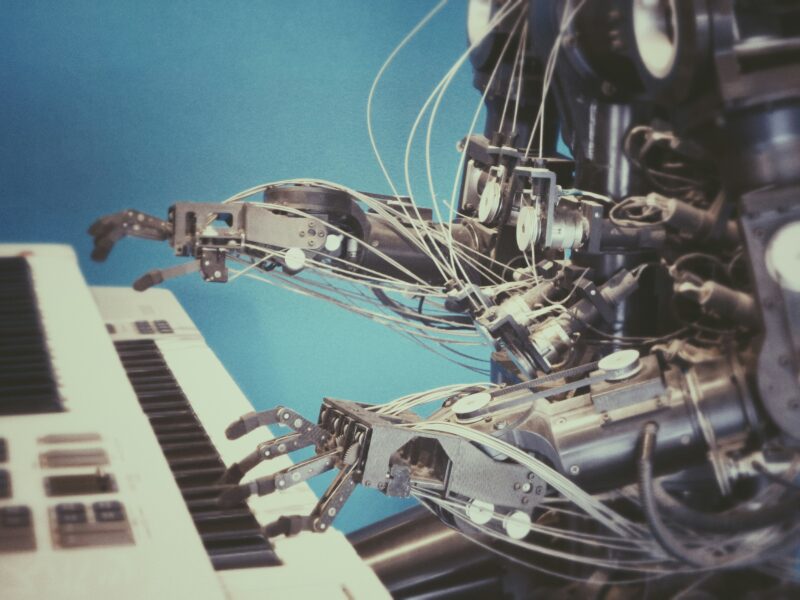On a l’impression que l’Intelligence Artificielle a débarqué un mardi matin de 2022 pour bouleverser nos vies. Faux. L’IA, c’est comme cette vieille connaissance du lycée qui a soudainement percé à Hollywood : elle a bossé dans l’ombre pendant 70 ans avant de devenir cool.
Pour optimiser votre travail avec l’IA aujourd’hui, il faut comprendre d’où elle vient. Spoiler : elle ne vient pas de la magie noire, mais des maths.

1 : Le Grand-Père des années 1950
Tout commence avec Alan Turing. Un génie britannique qui aimait les puzzles et n’aimait pas trop les nazis (il a décrypté leur machine Enigma).
Après la guerre, Turing se pose une question bizarre : « Les machines peuvent-elles penser ? » À l’époque, un ordinateur faisait la taille d’une salle de sport et avait la puissance de calcul d’une calculatrice solaire. Mais Turing imagine un concept fou : le Test de Turing.
L’idée : Vous discutez par clavier interposé avec deux interlocuteurs cachés derrière un rideau. L’un est un humain, l’autre une machine. Si vous n’arrivez pas à dire lequel est la machine, alors la machine a « gagné ». Elle a réussi à imiter l’intelligence.
La leçon pour nous : Dès le départ, le but de l’IA n’a pas été d’avoir « conscience » d’elle-même (désolé Terminator), mais de simuler la réponse humaine de manière convaincante. Gardez ça en tête : ChatGPT ne « sait » rien, il « imite » très bien.
2 : L’Hiver et le réveil de l’IA
Pendant des décennies, on a cru qu’on allait coder l’intelligence à la main.
- Humain : « Si il pleut, alors prends un parapluie. »
- Machine : « Compris. »
Le problème ? La vie est trop compliquée pour être mise en règles « Si/Alors ». Comment expliquez-vous à une machine comment reconnaître un chat ? « Il a des oreilles pointues » ? Un berger allemand aussi. « Il a des moustaches » ? Votre oncle René aussi. C’était l’impasse. On a appelé ça « l’Hiver de l’IA ». Plus de budget, plus d’espoir.
Puis, trois choses sont arrivées en même temps vers les années 2010 :
- Le Big Data : On a inondé le monde de données (merci Internet).
- La Puissance de calcul : Les cartes graphiques (merci les jeux vidéo) sont devenues monstrueuses.
- Une nouvelle méthode : Le Machine Learning.
3 : Les Poupées Russes (Comprendre le jargon pour briller en réunion)
C’est là que ça devient intéressant pour votre culture générale (et votre crédibilité). On confond souvent tout. Imaginons des poupées russes :
3.1. La grande poupée : L’Intelligence Artificielle (IA)
C’est le terme générique. C’est tout ce qui imite un comportement intelligent. Même le fantôme bleu dans Pac-Man, c’est de l’IA (très basique).
3.2. La poupée du milieu : Le Machine Learning (Apprentissage Automatique)
C’est la révolution. Au lieu de donner les règles à la machine, on lui donne les données et on la laisse trouver les règles toute seule.
Exemple simple : Au lieu de décrire un chat à la machine, on lui montre 1 million de photos de chats et 1 million de photos de « non-chats » (des chiens, des toasters, des pizzas). À la fin, la machine dit : « Je ne sais pas ce que c’est, mais j’ai remarqué que statistiquement, ce motif de pixels (une moustache) est souvent associé au label ‘Chat’. »
3.3. La petite poupée complexe : Le Deep Learning (Apprentissage Profond)
C’est du Machine Learning sous stéroïdes. On utilise des « réseaux de neurones artificiels ». Imaginez des couches et des couches de calculs qui s’empilent pour comprendre des choses ultra-complexes (la voix, la traduction, la conduite autonome). C’est ce qui a permis à l’ordinateur de battre le champion du monde de Go.
3.4. La toute dernière poupée : L’IA Générative (Celle qui nous intéresse)
Jusqu’à récemment, l’IA savait surtout classer (Ceci est un spam / Ceci n’est pas un spam). L’IA Générative (ChatGPT, Midjourney) a passé un cap : elle ne se contente pas d’analyser, elle crée. Elle a avalé tout Internet pour apprendre à prédire le mot suivant.

4 : Comment piloter ce truc au boulot ?
Maintenant que vous savez que votre outil est un imitateur statistique ultra-puissant gavé de données, comment l’utiliser sans se planter ?
Le Syndrome du Perroquet Savant
L’IA fonctionne par probabilités. Si vous lui demandez « Qui a peint la Joconde ? », elle répond « Léonard de Vinci » car ces mots sont souvent associés. Mais si vous lui demandez un truc obscur, elle peut « halluciner ». Elle va inventer une réponse très crédible, mais fausse, juste pour compléter la phrase de manière logique.
Votre stratégie au travail :
- Déléguez le « Premier Jet » : L’IA a lu plus de livres que vous n’en lirez en 10 vies. Utilisez-la pour résumer, structurer, brainstormer. C’est la fin de la page blanche.
- Soyez le Rédacteur en Chef : L’IA est votre stagiaire zélé mais un peu naïf. Elle produit du kilomètre de texte. Vous, vous devez vérifier les faits, ajouter la nuance, l’émotion et la stratégie.
- Contextualisez (Le Prompting) : Souvenez-vous du Machine Learning. La machine a besoin de contexte. Ne dites pas « Écris un mail ». Dites « Agis comme un commercial empathique, le client est mécontent du retard, écris un mail court pour s’excuser sans admettre de faute légale ». Là, vous guidez ses statistiques vers le bon résultat.
Que retenir ?
Nous sommes passés d’Alan Turing qui rêvait de machines jouant aux échecs, à des systèmes capables de passer le barreau d’avocat ou d’écrire du code informatique.
Mais rappelez-vous : aussi impressionnante soit-elle, l’IA n’a pas d’intention. Elle ne « veut » pas vous aider, ni vous remplacer. Elle prédit le prochain mot. À vous de décider quels mots vous voulez lui faire dire pour devenir plus productif, plus créatif et, paradoxalement, plus humain dans votre travail en vous libérant des tâches robotiques.
Alors, prêt à dompter la machine ?





